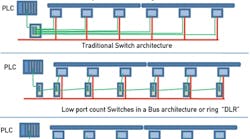Ethernet is replacing many traditional industrial communication networks as automation suppliers move to Ethernet for better performance and openness. The move to IP v6 is enhancing this move, since there will be enough IP addresses to provide "Ethernet to the Field Device" for many years. However, there are large numbers of plants and existing devices within plants, which were designed with older fieldbus technologies that pre-date Ethernet, and weren't designed to be used with it. These include Modbus Plus, Data Highway, GE Genius, Profibus, ControlNet, DeviceNet, InterbusS and many other RS232 or RS422 cables.
Some applications of the older fieldbuses have distances that can exceed the 300-ft limitation of Ethernet over copper wire, and, thus, will require fiber-optic cabling. The cost and complexity of running new cabling, especially if fiber is required, has prevented upgrades of certain applications, as they are not cost-effective Aboundi, the creation of Hong Yu, one of the developers of Modbus, is now attempting to remedy this problem. Its trademarked EtherHighway™ NetBridge™ will use the existing communication cable by injecting a broadband communication over the wire, and operating at speeds up to 90 MBPS.
"This will reduce the cost and potential disruptions when installing new cabling for existing systems. It will also eliminate the need to use fiber for communication distances greater than 300 feet, and you can keep your multidrop bus architecture and eliminate Ethernet switches and complex LLDP, DLR or rings," says Yu.
Ethernet topology is a major issue in wiring and installation costs. Traditional fieldbus wiring was optimized to work off a bus or daisy-chain wiring. Ethernet, on the other hand, is optimized to work in star or tree configurations. Creating a bus configuration from a traditional star configuration is a major issue when applying Ethernet in traditional I/O applications with distributed devices. Typically, users have had to use one Ethernet switch per bus drop, which obviously is extremely expensive. Often it is far too costly to even attempt the upgrade to Ethernet.
Another choice has been wireless. Wireless bridges eliminate wiring costs, but create other problems, including intermittent loss of signal and bandwidth loss (especially in 802.11 networks) They also make the network link non-deterministic. Aboundi's EtherHighway NetBridge operates at 90 Mbps UDP, which is two to four times faster than 802.11g wireless without issues of security and dead zones and intermittent operation. It also maintains the deterministic nature of the traditional fieldbus topologies.
Aboundi NetBridges layer Ethernet over high-frequency (broadband) communication over the common power wires (AC or DC voltages) and eliminate a need for a separate communication wire in I/O networks. They can extend wired communications to 600 m (2000 ft.) without fiber-optic cabling or network repeaters. NetBridges can create isolated channels and allow VLAN communications over a common wire by dividing broadcast frequencies into different channels.
Traditional fieldbus designs, such as Modbus Plus, Data Highway and Profibus, are capable of operating at cable lengths up to 2000 feet (610 m). While traditional Ethernet networks are limited to about 200 feet (61 m), Aboundi's NetBridges are capable of driving signals up to 2000 feet.
"This means that devices can remain located further apart than they would have to be with a standard Ethernet upgrade," Yu says. "All of this while using existing cable. NetBridges can even inject communication with magnetic coupling to eliminate the need to splice into existing wires."
For more information, go to www.aboundi.com.




